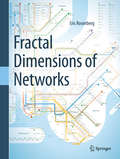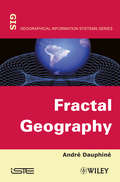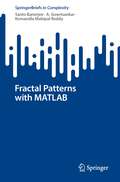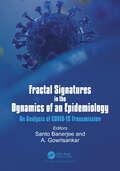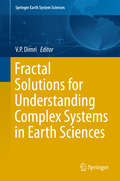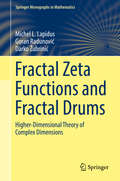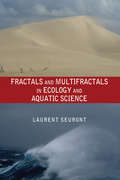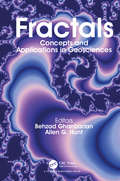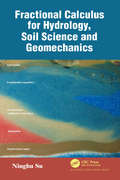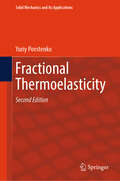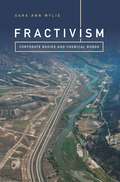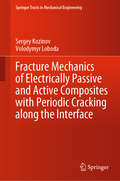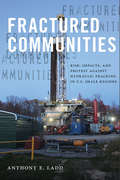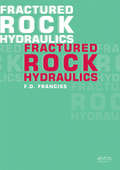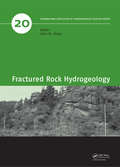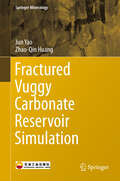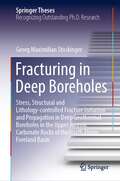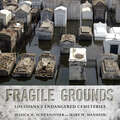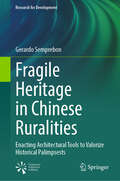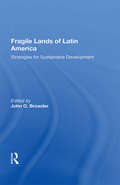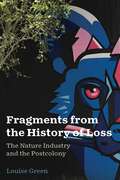- Table View
- List View
Fractal Dimensions of Networks (Springerbriefs In Computer Science Ser.)
by Eric RosenbergCurrent interest in fractal dimensions of networks is the result of more than a century of previous research on dimensions. Fractal Dimensions of Networks ties the theory and methods for computing fractal dimensions of networks to the “classic” theory of dimensions of geometric objects.The goal of the book is to provide a unified treatment of fractal dimensions of sets and networks. Since almost all of the major concepts in fractal dimensions originated in the study of sets, the book achieves this goal by first clearly presenting, with an abundance of examples and illustrations, the theory and algorithms for sets, and then showing how the theory and algorithms have been applied to networks. Thus, the book presents the classical theory and algorithms for the box counting dimension for sets, and then presents the box counting dimension for networks. All the major fractal dimensions are studied, e.g., the correlation dimension, the information dimension, the Hausdorff dimension, the multifractal spectrum, as well as many lesser known dimensions. Algorithm descriptions are accompanied by worked examples, many applications of the methods are presented, and many exercises, ranging in difficulty from easy to research level, are included.
Fractal Geography
by André DauphinéOur daily universe is rough and infinitely diverse. The fractal approach clarifies and orders these disparities. It helps us to envisage new explanations of geographical phenomena, which are, however, considered as definitely understood.Written for use by geographers and researchers from similar disciplines, such as ecologists, economists, historians and sociologists, this book presents the algorithms best adapted to the phenomena encountered, and proposes case studies illustrating their applications in concrete situations.An appendix is also provided that develops programs written in Mathematica.Contents1. A Fractal World.2. Auto-similar and Self-affine Fractals.3. From the Fractal Dimension to Multifractal Spectrums.4. Calculation and Interpretation of Fractal Dimensions.5. The Fractal Dimensions of Rank-size Distributions.6. Calculation and Interpretation of Multifractal Spectrums.7. Geographical Explanation of Fractal Forms and Dynamics.8. Using Complexity Theory to Explain a Fractal World.9. Land-use Planning and Managing a Fractal Environment.
Fractal Patterns with MATLAB (SpringerBriefs in Complexity)
by Santo Banerjee A. Gowrisankar Komandla Mahipal ReddyThis book presents the iterative beauty of fractals and fractal functions graphically with the aid of MATLAB programming. The fractal images generated using the MATLAB codes provide visual delight and highly encourage the fractal lovers for creative thinking. The book compiles five cutting-edge research chapters, each with state-of-the art fractal illustrations. It starts with the fundamental theory for the construction of fractal sets via the deterministic iteration algorithm. Incorporating the theoretical base, fractal illustrations of elementary fractal sets are provided with the explicit MATLAB code. The book gives examples of MATLAB codes to present the fractal surfaces. This book is contributed to all the research beginners as well as the professionals on the field of fractal analysis. As it covers basic fractals like Sierpinski triangle to advanced fractal functions with explicit MATLAB code, the presented fractal illustrations hopefully benefit even the non-field readers. The book is a useful course to all the research beginners on the fractal and fractal-related fields.
Fractal Signatures in the Dynamics of an Epidemiology: An Analysis of COVID-19 Transmission
by Santo Banerjee A. GowrisankarThe recent Covid-19 pandemic threw the world into complete chaos with its rapid and devastating spread. Scientists are still trying to obtain a better understanding of the patterns of COVID-19 and trying to get a deeper understanding of mutant strains and their pathogenicity by performing genomic sequences of more samples. Fractal-based analysis provides its unique forecasting policy to reduce the spread of COVID-19, and in general, of any outbreaks. The book presents fractal and multifractal models of COVID-19 and reviews the impact of the pandemic including epidemiology, genome organization, transmission cycle, and control strategies based on mathematical models towards developing an immune intervention. Also, it covers non-clinical aspects such as economic development with graphical illustrations, meeting the needs of onlookers outside the sector who desire additional information on the epidemic. The fractal signatures describe the fractal textures in the patterns of Corona virus. Studies on the epidemiology of Covid-19 in relation with the fractals and fractal functions serve to exhibit its irregular chaotic nature. Moreover, the book with its wide coverage on the Hurst exponent analysis and the fractal dimension estimation, greatly aids in measuring the epidemiology.
Fractal Solutions for Understanding Complex Systems in Earth Sciences
by V. P. DimriThis book deals with fractals in understanding problems encountered in earth science, and their solutions. It starts with an analysis of two classes of methods (homogeneous fractals random models, and homogeneous source distributions or "one point" distributions) widely diffused in the geophysical community, especially for studying potential fields and their related source distributions. Subsequently, the use of fractals in potential fields is described by scaling spectral methods for estimation of curie depth. The book also presents an update of the use of the fractal concepts in geological understanding of faults and their significance in geological modelling of hydrocarbon reservoirs. Geophysical well log data provide a unique description of the subsurface lithology; here, the Detrended Fluctuation Analysis technique is presented in case studies located off the west-coast of India. Another important topic is the fractal model of continuum percolation which quantitatively reproduce the flow path geometry by applying the Poiseuille's equation. The pattern of fracture heterogeneity in reservoir scale of natural geological formations can be viewed as spatially distributed self-similar tree structures; here, the authors present simple analytical models based on the medium structural characteristics to explain the flow in natural fractures. The Fractal Differential Adjacent Segregation (F-DAS) is an unconventional approach for fractal dimension estimation using a box count method. The present analysis provides a better understanding of variability of the system (adsorbents - adsorbate interactions). Towards the end of book, the authors discuss multi-fractal scaling properties of seismograms in order to quantify the complexity associated with high-frequency seismic signals. Finally, the book presents a review on fractal methods applied to fire point processes and satellite time-continuous signals that are sensitive to fire occurrences.
Fractal Zeta Functions and Fractal Drums: Higher-Dimensional Theory of Complex Dimensions (Springer Monographs in Mathematics)
by Michel L. Lapidus Goran Radunović Darko ŽubrinićThis monograph gives a state-of-the-art and accessible treatment of a new general higher-dimensional theory of complex dimensions, valid for arbitrary bounded subsets of Euclidean spaces, as well as for their natural generalization, relative fractal drums. It provides a significant extension of the existing theory of zeta functions for fractal strings to fractal sets and arbitrary bounded sets in Euclidean spaces of any dimension. Two new classes of fractal zeta functions are introduced, namely, the distance and tube zeta functions of bounded sets, and their key properties are investigated. The theory is developed step-by-step at a slow pace, and every step is well motivated by numerous examples, historical remarks and comments, relating the objects under investigation to other concepts. Special emphasis is placed on the study of complex dimensions of bounded sets and their connections with the notions of Minkowski content and Minkowski measurability, as well as on fractal tube formulas. It is shown for the first time that essential singularities of fractal zeta functions can naturally emerge for various classes of fractal sets and have a significant geometric effect. The theory developed in this book leads naturally to a new definition of fractality, expressed in terms of the existence of underlying geometric oscillations or, equivalently, in terms of the existence of nonreal complex dimensions. The connections to previous extensive work of the first author and his collaborators on geometric zeta functions of fractal strings are clearly explained. Many concepts are discussed for the first time, making the book a rich source of new thoughts and ideas to be developed further. The book contains a large number of open problems and describes many possible directions for further research. The beginning chapters may be used as a part of a course on fractal geometry. The primary readership is aimed at graduate students and researchers working in Fractal Geometry and other related fields, such as Complex Analysis, Dynamical Systems, Geometric Measure Theory, Harmonic Analysis, Mathematical Physics, Analytic Number Theory and the Spectral Theory of Elliptic Differential Operators. The book should be accessible to nonexperts and newcomers to the field.
Fractals and Multifractals in Ecology and Aquatic Science
by Laurent SeurontEcologists sometimes have a less-than-rigorous background in quantitative methods, yet research within this broad field is becoming increasingly mathematical. Written in a step-by-step fashion, Fractals and Multifractals in Ecology and Aquatic Science provides scientists with a basic understanding of fractals and multifractals and the techniques fo
Fractals: Concepts and Applications in Geosciences
by Behzad Ghanbarian Allen G. HuntThis book provides theoretical concepts and applications of fractals and multifractals to a broad range of audiences from various scientific communities, such as petroleum, chemical, civil and environmental engineering, atmospheric research, and hydrology. In the first chapter, we introduce fractals and multifractals from physics and math viewpoints. We then discuss theory and practical applications in detail. In what follows, in chapter 2, fragmentation process is modeled using fractals. Fragmentation is the breaking of aggregates into smaller pieces or fragments, a typical phenomenon in nature. In chapter 3, the advantages and disadvantages of two- and three-phase fractal models are discussed in detail. These two kinds of approach have been widely applied in the literature to model different characteristics of natural phenomena. In chapter 4, two- and three-phase fractal techniques are used to develop capillary pressure curve models, which characterize pore-size distribution of porous media. Percolation theory provides a theoretical framework to model flow and transport in disordered networks and systems. Therefore, following chapter 4, in chapter 5 the fractal basis of percolation theory and its applications in surface and subsurface hydrology are discussed. In chapter 6, fracture networks are shown to be modeled using fractal approaches. Chapter 7 provides different applications of fractals and multifractals to petrophysics and relevant area in petroleum engineering. In chapter 8, we introduce the practical advantages of fractals and multifractals in geostatistics at large scales, which have broad applications in stochastic hydrology and hydrogeology. Multifractals have been also widely applied to model atmospheric characteristics, such as precipitation, temperature, and cloud shape. In chapter 9, these kinds of properties are addressed using multifractals. At watershed scales, river networks have been shown to follow fractal behavior. Therefore, the applications of fractals are addressed in chapter 10. Time series analysis has been under investigations for several decades in physics, hydrology, atmospheric research, civil engineering, and water resources. In chapter 11, we therefore, provide fractal, multifractal, multifractal detrended fluctuation analyses, which can be used to study temporal characterization of a phenomenon, such as flow discharge at a specific location of a river. Chapter 12 addresses signals and again time series using a novel fractal Fourier analysis. In chapter 13, we discuss constructal theory, which has a perspective opposite to fractal theories, and is based on optimizationof diffusive exchange. In the case of river drainages, for example, the constructal approach begins at the divide and generates headwater streams first, rather than starting from the fundamental drainage pattern.
Fractional Calculus for Hydrology, Soil Science and Geomechanics: An Introduction to Applications
by Ninghu SuThis book is an unique integrated treatise, on the concepts of fractional calculus as models with applications in hydrology, soil science and geomechanics. The models are primarily fractional partial differential equations (fPDEs), and in limited cases, fractional differential equations (fDEs). It develops and applies relevant fPDEs and fDEs mainly to water flow and solute transport in porous media and overland, and in some cases, to concurrent flow and energy transfer. It is an integrated resource with theory and applications for those interested in hydrology, hydraulics and fluid mechanics. The self-contained book summaries the fundamentals for porous media and essential mathematics with extensive references supporting the development of the model and applications.
Fractional Dynamic Calculus and Fractional Dynamic Equations on Time Scales
by Svetlin G. GeorgievPedagogically organized, this monograph introduces fractional calculus and fractional dynamic equations on time scales in relation to mathematical physics applications and problems. Beginning with the definitions of forward and backward jump operators, the book builds from Stefan Hilger’s basic theories on time scales and examines recent developments within the field of fractional calculus and fractional equations. Useful tools are provided for solving differential and integral equations as well as various problems involving special functions of mathematical physics and their extensions and generalizations in one and more variables. Much discussion is devoted to Riemann-Liouville fractional dynamic equations and Caputo fractional dynamic equations. Intended for use in the field and designed for students without an extensive mathematical background, this book is suitable for graduate courses and researchers looking for an introduction to fractional dynamic calculus and equations on time scales.
Fractional Equations and Models: Theory and Applications (Developments in Mathematics #61)
by Trifce Sandev Živorad TomovskiFractional equations and models play an essential part in the description of anomalous dynamics in complex systems. Recent developments in the modeling of various physical, chemical and biological systems have clearly shown that fractional calculus is not just an exotic mathematical theory, as it might have once seemed. The present book seeks to demonstrate this using various examples of equations and models with fractional and generalized operators. Intended for students and researchers in mathematics, physics, chemistry, biology and engineering, it systematically offers a wealth of useful tools for fractional calculus.
Fractional Thermoelasticity (Solid Mechanics and Its Applications #278)
by Yuriy PovstenkoThis new edition offers expanded coverage of fractional calculus, including Riemann–Liouville fractional integrals, Riemann–Liouville and Caputo fractional derivatives, Riesz fractional operators, and Mittag-Leffler and Wright functions. Additionally, it provides a comprehensive examination of fractional heat conduction and related theories of thermoelasticity. Readers will gain insights into the concepts of time and space nonlocality and their impact on the generalizations of Fourier's law in thermoelasticity. This edition presents a detailed formulation of the problem of heat conduction in different domains and the associated thermal stresses, covering topics such as the fundamental solution to the Dirichlet problem, constant boundary conditions for temperature, and the fundamental solution to the physical Neumann problem. New insights into time-harmonic heat impact on the boundary have also been added. Cracks in the framework of fractional thermoelasticity are also considered.
Fractional-in-Time Semilinear Parabolic Equations and Applications (Mathématiques et Applications #84)
by Ciprian G. Gal Mahamadi WarmaThis book provides a unified analysis and scheme for the existence and uniqueness of strong and mild solutions to certain fractional kinetic equations. This class of equations is characterized by the presence of a nonlinear time-dependent source, generally of arbitrary growth in the unknown function, a time derivative in the sense of Caputo and the presence of a large class of diffusion operators. The global regularity problem is then treated separately and the analysis is extended to some systems of fractional kinetic equations, including prey-predator models of Volterra–Lotka type and chemical reactions models, all of them possibly containing some fractional kinetics. Besides classical examples involving the Laplace operator, subject to standard (namely, Dirichlet, Neumann, Robin, dynamic/Wentzell and Steklov) boundary conditions, the framework also includes non-standard diffusion operators of "fractional" type, subject to appropriate boundary conditions.This book is aimed at graduate students and researchers in mathematics, physics, mathematical engineering and mathematical biology, whose research involves partial differential equations.
Fractivism: Corporate Bodies and Chemical Bonds
by Sara Ann WylieFrom flammable tap water and sick livestock to the recent onset of hundreds of earthquakes in Oklahoma, the impact of fracking in the United States is far-reaching and deeply felt. In Fractivism Sara Ann Wylie traces the history of fracking and the ways scientists and everyday people are coming together to hold accountable an industry that has managed to evade regulation. Beginning her story in Colorado, Wylie shows how nonprofits, landowners, and community organizers are creating novel digital platforms and databases to track unconventional oil and gas well development and document fracking's environmental and human health impacts. These platforms model alternative approaches for academic and grassroots engagement with the government and the fossil fuel industry. A call to action, Fractivism outlines a way forward for not just the fifteen million Americans who live within a mile of an unconventional oil or gas well, but for the planet as a whole.
Fracture Mechanics of Electrically Passive and Active Composites with Periodic Cracking along the Interface (Springer Tracts in Mechanical Engineering)
by Volodymyr Loboda Sergey KozinovThis book offers a comprehensive and timely review of the fracture behavior of bimaterial composites consisting of periodically connected components, i.e. of bimaterial composites possessing periodical cracks along the interface. It first presents an overview of the literature, and then analyzes the isotropic, anisotropic and piezoelectric/dielectric properties of bimaterial components, gradually increasing the difficulty of the solutions discussed up to the coupled electromechanical problems. While in the case of isotropic and anisotropic materials it covers the problems generated by an arbitrary set of cracks, for the piezoelectric materials it focuses on studying the influence of the electric permittivity of the crack’s filler, using not only a simple, fully electrically permeable model, but also a physically realistic, semi-permeable model. Throughout the analyses, the effects of the contact of the crack faces are taken into account so as to exclude the physically unrealistic interpenetration of the composite components that are typical of the classical open model. Further, the book derives and examines the mechanical and electromechanical fields, stress and electric intensity factors in detail. Providing extensive information on the fracture processes taking place in composite materials, the book helps readers become familiar with mathematical methods of complex function theory for obtaining exact analytical solutions.
Fractured Cities: Capitalism, Community and Empowerment in Britain and America
by Brian D. JacobsAnglo-American cities face economic decline, social polarisation and racial conflict. Their fate is increasingly decided by the global actions of transnational corporations and market forces. Community groups find it difficult to gain access to the political system. Ethnic minorities strive for empowerment while indebted city governments battle to maintain basic services. Such is the urban crisis of the 1990s. Fractured Cities describes the political economy of urban change and explores the future of the city.
Fractured Communities: Risk, Impacts, and Protest Against Hydraulic Fracking in U.S. Shale Regions (Nature, Society, and Culture)
by Peter Hall Stephanie A. Malin Suzanne Staggenborg Anthony E. Ladd Hilary Boudet Sherry Cable Brittany Gaustad James Maples Tamara Mix Carmel Price Dakota K.T. Raynes Stacia Ryder Trang Tran Ion Bogdan Vasi Cameron Thomas Whitley Patricia WidenerWhile environmental disputes and conflicts over fossil fuel extraction have grown in recent years, few issues have been as contentious in the twenty-first century as those surrounding the impacts of unconventional natural gas and oil development using hydraulic drilling and fracturing techniques—more commonly known as “fracking”—on local communities. In Fractured Communities, Anthony E. Ladd and other leading environmental sociologists present a set of crucial case studies analyzing the differential risk perceptions, socio-environmental impacts, and mobilization of citizen protest (or quiescence) surrounding unconventional energy development and hydraulic fracking in a number of key U.S. shale regions. Fractured Communities reveals how this contested terrain is expanding, pushing the issue of fracking into the mainstream of the American political arena.
Fractured Rock Hydraulics
by Fernando Olavo FrancissUniquely devoted to hard and fractured rock hydraulics, this advanced-level introduction provides tools to solve practical engineering problems. Chapter I covers the fundamentals of fractured rock hydraulics under a tensor approach. Chapter II presents some key concepts about approximate solutions. Chapter III discuss a few data analysis techniques
Fractured Rock Hydrogeology (ISSN)
by John M. SharpUnderstanding of groundwater flow and solute transport in fractured rocks is vital for analysis of water resources, water quality and environmental protection, geotechnical and engineering projects, and geothermal energy production. This book includes theoretical and practical analyses using numerical modelling, geochemistry, isotopes, aquifer tests, laboratory tests, field mapping, geophysics, geological analyses, and some unique combinations of these types of investigation. Current water resource and geotechnical problems and the techniques now used are also discussed. Aimed at practicing hydrogeologists, engineers, ecologists, resource managers, students and earth scientists.
Fractured Vuggy Carbonate Reservoir Simulation (Springer Mineralogy)
by Jun Yao Zhao-Qin HuangThis book solves the open problems in fluid flow modeling through the fractured vuggy carbonate reservoirs. Fractured vuggy carbonate reservoirs usually have complex pore structures, which contain not only matrix and fractures but also the vugs and cavities. Since the vugs and cavities are irregular in shape and vary in diameter from millimeters to meters, modeling fluid flow through fractured vuggy porous media is still a challenge. The existing modeling theory and methods are not suitable for such reservoir. It starts from the concept of discrete fracture and fracture-vug networks model, and then develops the corresponding mathematical models and numerical methods, including discrete fracture model, discrete fracture-vug model, hybrid model and multiscale models. Based on these discrete porous media models, some equivalent medium models and methods are also discussed. All the modeling and methods shared in this book offer the key recent solutions into this area.
Fracturing in Deep Boreholes: Stress, Structural and Lithology-controlled Fracture Initiation and Propagation in Deep Geothermal Boreholes in the Upper Jurassic Carbonate Rocks of the North Alpine Foreland Basin (Springer Theses)
by Georg Maximilian StockingerThe development of the base-load capable, climate-friendly, and practically inexhaustible source of "geothermal energy" represents an important pillar of the energy supply of the future. If it were possible to expand geothermal energy production accordingly, Germany could generate 100% of its energy in a climate-neutral manner by 2050. The joint research project "Dolomitkluft," funded by the German Federal Ministry for Economic Affairs and Energy from 2016 to 2018, aims to establish a new and improved reservoir model for the Upper Jurassic carbonates of the Northern Alpine Foreland Basin for deep geothermal energy. Emerged from this project, the dissertation by Mr. Stockinger geomechanically and numerically characterizes the deep geothermal reservoir in carbonate rocks—limestones and dolomites—of the Upper Jurassic in the Northern Alpine Foreland Basin in over 4000 m depth. This book specifically addresses fracture initiation, propagation, and hydraulic conductivity around a borehole and their controlling factors such as the in situ stress, the existing discontinuity network, and the geomechanical rock properties. Mr. Stockinger has thus successfully addressed the most important aspects for the retrievability of deep geothermal energy at its point of origin—namely the (deep) borehole.
Fragile Grounds: Louisiana's Endangered Cemeteries (America's Third Coast Series)
by Mary H. Manhein Jessica H. SchexnayderRecipient of a 2018 Preserve Louisiana Award and a 2018 Coastal Stewardship AwardFragile Grounds compiles stories and photographs of endangered cemeteries throughout Louisiana's coastal zone and beyond. These burial places link the fragile land to the frailty of the state's threatened community structures. The book highlights the state's vibrant diversity by showing its unique burial customs and traditions, while it also identifies the urgent need for ongoing documentation of cultural elements at risk.Cemeteries associated with the culturally rich communities of Louisiana reflect the history and global settlement patterns of the state. Yet many are endangered due to recurring natural and man-made events. Nearly 80 percent of the nation's coastal land loss occurs in Louisiana. Coastal erosion, sinking land, flooding, storm surge, and sea-level rise have led to an inland migration that threatens to unravel the fabric of Louisiana and, by association, hastens the demise of its burial places.As people are forced inland, migrants abandon, neglect, or often overlook cemeteries as part of the cultural landscape. In terms of erosion, when the land goes, the cemetery goes with it. Cemeteries fall prey to inland and coastal flooding. As cities grow outward, urban sprawl takes over the landscape. Cemeteries lose out to forces such as expansion, eminent domain, and urban neglect. Not only do cemeteries give comfort for the living, but they also serve as a vital link to the past. Once lost, that past cannot be recovered.
Fragile Heritage in Chinese Ruralities: Enacting Architectural Tools to Valorize Historical Palimpsests (Research for Development)
by Gerardo SemprebonThis book explores the concept of fragile heritage as an architectural legacy and a territorial resource in rural China, emphasizing the significance in safeguarding its unique cultural trajectory, and laying the groundwork for future developments. Chinese rural buildings and settlements encapsulate priceless cultural values, but become increasingly vulnerable, under increasing pressures. Socioeconomic transitions, climate change, political agendas, land rent speculation, awakenings, and commodifications of cultural values, redefine the conceptual and operational framework of countryside transformation, and contribute to the debate on contemporary architectural and urban design. In this context, rural authenticity emerges as a crucial value in architectural morpho-typology, construction techniques, and expressive codes. The book introduces the notion of fragile heritage as the crossroad between folklore, academia, and practice. Next, it put in place reading methods to frame rural settlements as cultural palimpsests, indissolubly tying architectures to the landscape. These concepts are then applied to a multiscalar analysis of fifteen traditional architectures to uncover rural space and society's physical and cultural dimensions. Finally, it discusses recent revitalization projects, highlighting the potential role of architectural design. The research methodology relies on fieldwork campaigns in the Fujian and Zhejiang Provinces of China between 2017 and 2019 and a subsequent critical ri-elaboration that leverages the graphic apparatus as the fundamental investigative tool. The central idea put forward in this book is that, between tradition and innovation, the fragile heritage of past societies needs a cultural translation, interpretation, and negotiation to find space and life in the contemporary milieu.
Fragile Lands Of Latin America: Strategies For Sustainable Development
by John O. BrowderThis book of selected research papers, originally presented at the "Symposium of Fragile Lands of Latin America—The Search for Sustainable Uses," presents some fresh evidence of the viability of a few "non-conventional" strategies for natural resource development and management.
Fragments from the History of Loss: The Nature Industry and the Postcolony (AnthropoScene)
by Louise GreenThe Anthropocene’s urgent message about imminent disaster invites us to forget about history and to focus on the present as it careens into an unthinkable future. To counter this, Louise Green engages with the theoretical framing of nature in concepts such as the “Anthropocene,” “the great acceleration,” and “rewilding” in order to explore what the philosophy of nature in the era of climate change might look like from postcolonial Africa.Utilizing a practice of reading developed in the Frankfurt school, Green rearranges narrative fragments from the “global nature industry,” which subjugates all aspects of nature to the logic of capitalist production, in order to disrupt preconceived notions and habitual ways of thinking about how we inhabit the Anthropocene. Examining climate change through the details of everyday life, particularly the history of conspicuous consumption and the exploitation of Africa, she surfaces the myths and fantasies that have brought the world to its current ecological crisis and that continue to shape the narratives through which it is understood. Beginning with African rainforest exhibits in New York and Cornwall, Green discusses how these representations of the climate catastrophe fail to acknowledge the unequal pace at which humans consume and continue to replicate imperial narratives about Africa. Examining this history and climate change through the lens of South Africa’s entry into capitalist modernity, Green argues that the Anthropocene redirects attention away from the real problem, which is not human’s relation with nature, but people’s relations with each other.A sophisticated, carefully argued call to rethink how we approach relationships between and among humans and the world in which we live, Fragments from the History of Loss is a challenge to both the current era and the scholarly conversation about the Anthropocene.
